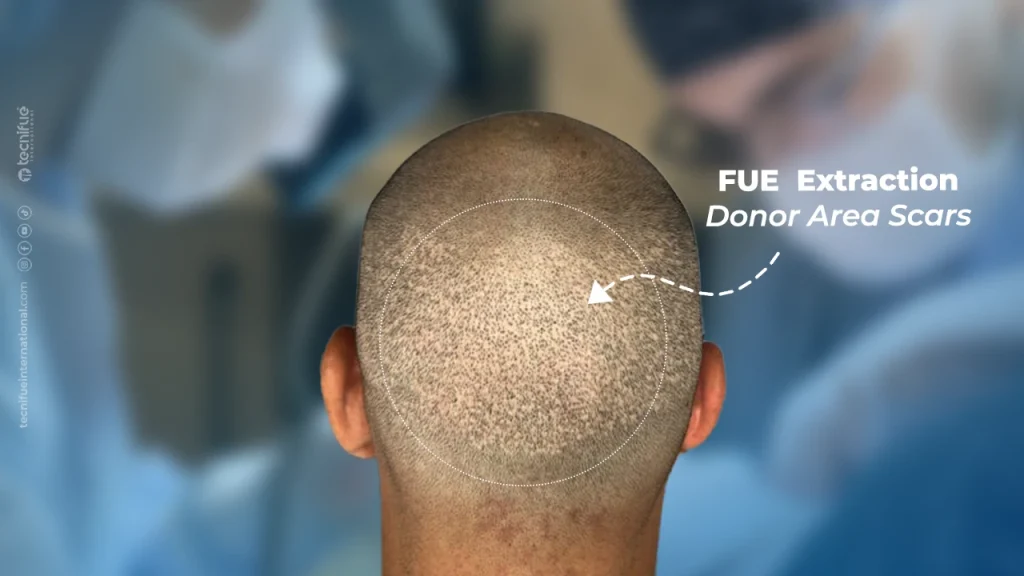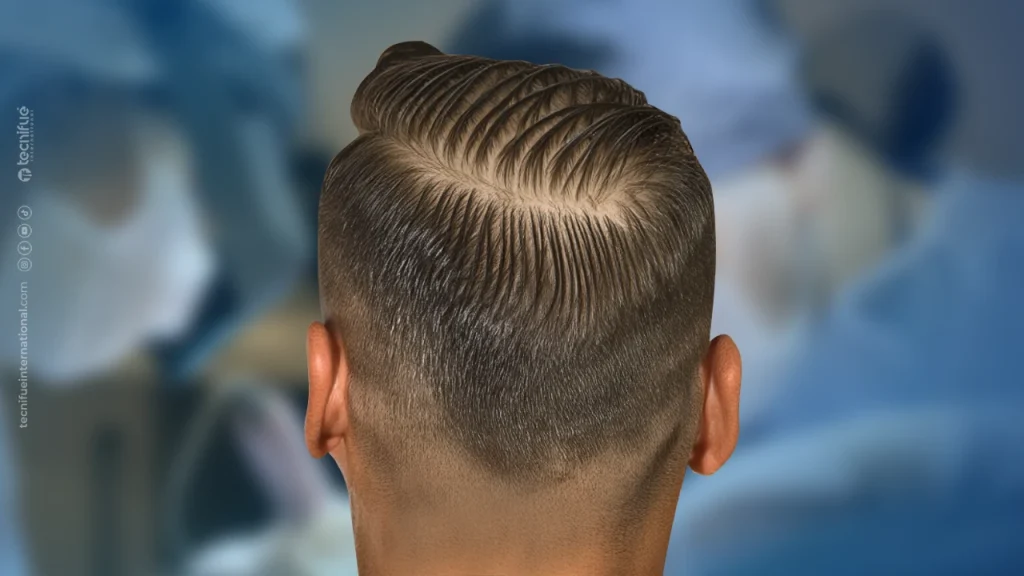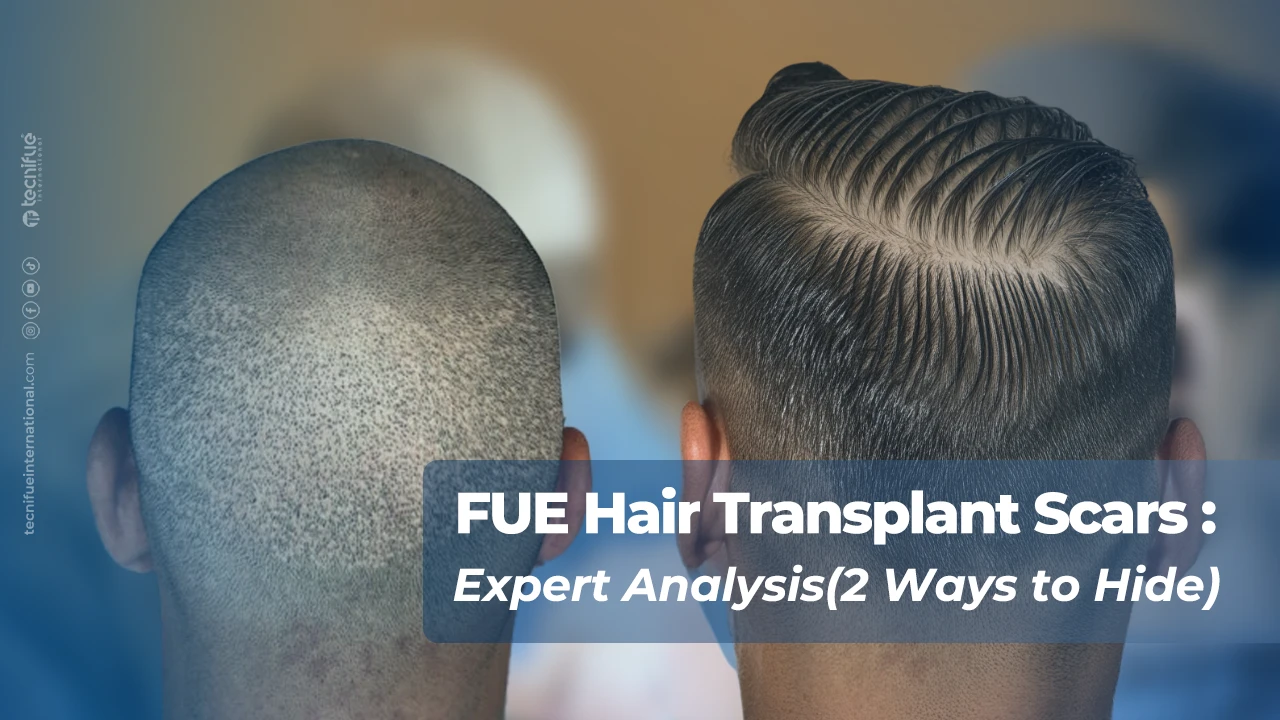If you’re considering a FUE Hair Transplant or have had one, you may want to know more about FUE Hair Transplant scars.
Scars are a significant concern for many people like you who are thinking about a hair transplant.
There is still some confusion about the types of scars caused by different hair transplant methods.
In this blog, I will clear up this confusion and answer the common questions we get asked daily as hair transplant experts.
For example, one common question is:
Do FUE scars fade over time?
If you’re seeking answers to questions about FUE Hair Transplant scars, you’re in the right place.
By the time you finish reading this blog, you’ll be well-informed about FUE scars, clearing up any confusion you may have had.
Before we delve into the topic, let me introduce myself if you’re new to our site.
I’m James, the co-founder of Tecnifue International, a leading hair restoration clinic in Turkey.
Since 2012, we’ve been providing premium services to thousands of patients from around the globe.
Now that you know us, let’s return to our topic of FUE Hair Transplant scars.
Let’s dive in.
What are FUE Hair Transplant Scars?
If you know a bit about the FUE Hair Transplant method, you might be thinking:
“Wait a second, I thought there were no scars with this method.”
Don’t worry; there are no significant scars.
At least, not the type of scars you might be imagining.
Here’s why:
The scar that most people fear is a big horizontal scar at the back of the head (donor area).
This type of scar is not the same as FUE scars.
The “big” scar is caused by the extraction method known as the FUT Hair Transplant method.
Now that we’ve clarified this let’s take a quick look at what scar tissue is before explaining in detail what FUE Hair Transplant scars are.

Understanding Scar Tissue
Here’s a simplified explanation of what scar tissue is.
When our body gets hurt by a cut, burn, or surgery, it tries to fix itself.
This process creates something called scar tissue.
Think of scar tissue as a patch that covers and protects the injured area while it heals.
It’s like when you patch up a hole in your clothes.
Scar tissue isn’t exactly like the original skin or tissue.
It’s tougher and less flexible.
This is why scars can look and feel different from the rest of your skin.
You can see it as the body’s way of healing, but it’s not a perfect fix.
In summary, scar tissue forms when our body repairs damage from injuries or diseases.
It’s important to remember that scar tissue is a natural part of healing.
Now that you understand what we mean by scar tissue let’s have a more detailed look at FUE Hair Transplant Scars.
Understanding FUE Hair Transplant Scars
When we refer to FUE Hair Transplant scars, we mean small white dots at the extraction sites.
When a graft is taken out, no hair will grow back at that exact spot, leaving a small white dot.
The good news?
These dots are not visible if the hair at the back is kept at a certain length.
The surrounding hair covers the small dots when it grows longer.
We will illustrate this with images for better understanding.
How long do FUE scars take to heal?
There are two healing phases for FUE scars.
The initial healing phase involves the complete recovery of scabs at the donor area.
When a graft is taken out from the donor site, it leaves a small hole, which is closed by a small scab as part of the recovery.
When these tiny scabs have fallen off, the first healing phase is considered complete.
What is the second healing phase of FUE hair transplant scars?
The second phase takes much longer and can be considered the actual healing phase of the scar tissue.
As experts, we use 8 months as a reference.
This is because we consider the donor site ready for another hair transplant extraction 8 months after the first extraction date.
You might think, “Wow, that’s long.”
But don’t worry.
This doesn’t mean you’ll be dealing with side effects or discomfort during this period.
Most patients don’t feel any discomfort at all from the donor site a few weeks after their hair surgery.
The scar tissue heals gradually over time.
Now that we’ve covered this, what’s next?
In the next topic, I will discuss FUE Hair Transplant Scars vs. Overharvesting.
There are quite a few misunderstandings on this topic as well.
Let’s continue.
FUE Hair Transplant Scars vs. Overharvesting
Let me explain this as simply as possible.
FUE Hair Transplant scars are the natural result of a FUE hair transplant extraction.
So, it’s very typical to have scars in the donor area.
Overharvesting, however, is the result of a poor extraction process.
This will be visible as areas with bald patches or very thin zones.
Simply put, overharvesting occurs when too many grafts are extracted from a single area.
Let’s dive deeper to understand the difference between overharvesting and normal scars.
Let’s assume that one cm² has 80 hair follicles.
A standard extraction would remove 35-40 follicles.
This means that the sites of the extracted grafts will become scabs.
However, since there are still plenty of remaining grafts, this will not be visible when the remaining hair grows longer.
The remaining hair will cover the extracted zones perfectly.
Now, imagine another scenario.
Imagine that 60-65 grafts are extracted from the same one cm² with only 80 hair follicles.
You guessed it right.
That won’t look very good; you will see a clear bald spot and thinning in that area.
So, FUE hair transplant scars are normal, but overharvesting is not; it results from a poor extraction protocol.
I know we’re getting deep into this, but if you know my work by now, you understand why.
The more you know, the better choices you can make.
I am here to ensure that everyone considering hair restoration has access to complete and correct information.
What’s next?
Next, I will discuss a similar topic.
I will explain the difference between FUE Hair Transplant Scars and Shock Loss.
Let’s continue.
FUE Scars vs. Shock Loss Explained
You know what FUE hair transplant scars are by now, so I won’t repeat that.
But what is shock loss?
I have explained this extensively in our “FUE Hair Transplant Timeline: Best Expert Guide (1 Year Period).”
So, if you want an in-depth understanding of shock loss, read our guide.
But let me touch on this quickly to explain why it’s important.
Shock loss is sometimes mistaken for a hair transplant scar, but it’s not.
Here’s why:
Shock loss is temporary, as you can read in our guide.
FUE scars are not.
That’s the main difference, and it’s important to understand.
Let’s continue with another exciting topic.
How to Reduce FUE Scarring?
This is not the most obvious question and requires some deeper thinking.
A patient asked this question a few years ago, and it’s a very fair and good question.
Let’s create the right groundwork first to answer this question precisely.
We should know that FUE hair transplant scars are inevitable; they are part of the process.
However, although inevitable, scars can be reduced.
Let me explain.
One obvious way is to extract fewer grafts.
This is quite obvious, and I agree.
This is feasible if you need a smaller number of grafts.
But there are two less apparent answers for you.
Two Ways of Reducing FUE Hair Transplant Scars
The first less obvious way is related to using a smaller punch size for extraction.
A smaller punch size translates to a smaller extraction hole, thus ultimately smaller scar tissue.
The optimum size of the punch needs to be determined based on the hair profile and structure.
This is important.
A punch size that is too small could damage grafts or negatively impact the extraction of multiple hair grafts.
In simpler terms, while reducing the size of the FUE scars is important, it’s of secondary importance compared to extracting healthy follicles.
This is a critical balance that must be sought by medical professionals.
If you need further explanation, please feel free to contact our Medical Consultants for more details.
What’s the second way of reducing FUE scars?
The second way of reducing FUE Hair Transplant scars is by taking the necessary time to extract the grafts.
Let me explain this with another numerical example.
Let’s say we have two patients, both needing 4,000 grafts.
Both procedures start at 9 am.
The extraction for Patient 1 takes 1 hour and 15 minutes.
The extraction for Patient 2 takes 2 hours and 15 minutes.
For clarity, let’s assume they are identical twins with the same hair profiles and donor area complexity.
Here’s my point: When a doctor extracts the grafts very quickly, the risk of damaging them increases.
The second issue is that faster extraction can lead to more tissue damage.
More tissue damage means more significant scar tissue.
I understand that such topics are challenging to understand, yet they are critical to know.
Understanding the basics will give you a significant advantage in your decisions regarding hair restoration.
What’s next?
What happens to the FUE scars over time?
Let’s discuss.
Do FUE Scars Fade Over Time?
Yes, they do.
You will see the FUE scars fade over time.
The way FUE scars look in the first few months after surgery is different from the end of the first year.
This is due to the further healing of the scar tissue, which gets smaller and smaller over time.
How to Hide FUE Scars
While FUE hair transplant scars are permanent, there are excellent ways to hide them.
One obvious way is to grow the hair long at the donor site.
You might be thinking,
“But I like wearing my hair short at the back.”
The fade hairstyle is very popular, and I can relate to this concern as I’ve worn one myself for many years.
So, how can you still have short hair at the back and hide the FUE scars?
Let’s focus on two ways I always advise our patients:
Hide the FUE Scar with a Good Fade Haircut
There are two options here.
The first option is to explain to your hairdresser to work on the fade so that the fade’s starting point will be at the border of the extraction points.
This way, the extraction white dots won’t be visible.
A good hairdresser will know exactly what you mean.
It might take a few haircuts, but most hairdressers find an excellent balance to meet your needs after a few tries.

Use SMP to Hide the FUE Scar
The second solution is more invasive and permanent.
You could consider SMP (scalp micro pigmentation) to cover the dots.
Consider this option only if you wear your hair very short to the skin.
If you don’t, there is no reason to consider SMP since the remaining hairs will cover the small scars without a problem.
Now you know how to hide FUE hair transplant scars.
Before we sum up, we have one more topic to cover.
Our final topic is related to another misunderstanding about FUE scars, specifically whether there is any difference between DHI and FUE scars.
Let me explain.
What is the Difference Between DHI and FUE Scars?
The only correct answer is absolutely nothing.
You can read our DHI Hair Transplant and FUE Hair Transplant blog, where I explain the workings of both methods in detail.
Spoiler alert if you haven’t read them yet.
The extraction method for both is exactly the same.
DHI and FUE differ in implantation methodology, not in extraction.
Since the extraction is the same, there can’t be any difference in FUE and DHI scars.
More explicitly, the extraction scars of FUE and DHI are 100% the same.
Summing Up
There you go.
You should have a very good idea now about Feasing hair transplant scars.
Let me summarize so you have a quick overview if you want to revisit the site and refresh your memory on the key topics of the Fue hair transplant scars.
FUE Hair Transplant Scars
FUE hair transplant scars are a common concern for many people considering this procedure.
These scars are small white dots at the extraction sites where no hair will grow back.
However, these dots are not visible if the surrounding hair is kept at a certain length.
Healing Phases
There are two healing phases for FUE scars.
The initial phase involves the recovery of scabs at the donor area, which typically falls off after a short period.
The second, longer phase involves the gradual healing of the scar tissue, which can take up to 8 months.
Overharvesting
Overharvesting occurs when too many grafts are extracted from a single area, resulting in bald patches or very thin zones.
Proper extraction ensures the remaining hair covers the extracted zones, preventing visible scarring.
Shock Loss
Shock loss, often mistaken for scars, is a temporary hair loss following the procedure. Unlike scars, shock-loss hair usually regrows over time.
Reducing FUE Scars
Scarring can be reduced by extracting fewer grafts and using a smaller punch size for extraction.
A balance must be maintained to ensure the extraction of healthy follicles.
Taking adequate time to extract grafts also helps minimize tissue damage and scarring.
Hiding FUE Scars
FUE scars can be hidden by growing the hair longer at the donor site.
For those who prefer short hair, a skilled hairdresser can style a faded haircut to conceal the scars.
Scalp micro-pigmentation (SMP) is another option for those wearing short hair.
FUE vs. DHI Scars
There is no difference between FUE and DHI scars, as both methods use the same extraction technique.
The difference lies in the implantation methodology rather than the extraction process.
Final Note
Deciding on a hair transplant is not easy, which is quite understandable.
You are making a decision that will impact you for the rest of your life.
The starting point with any aesthetic decision is understanding what you are dealing with.
By digging a bit deeper in your research, you will get much better answers.
So, here’s my advice to you: Keep digging deeper.
Do your research and make sure you only choose a clinic once you feel confident in your decision.
Don’t rush into it.
Having ethical experts by your side can be a true blessing in this journey.
Therefore, feel free to contact us if you need support in your hair transplant journey.
Let one of our Medical Consultants be your guide.
Hair Transplant Consultation
If you are at the stage of deciding to go for a hair transplant, feel free to reach out to us.
At Tecnifue International, we have been part of the hair restoration sector in Turkey since early 2012 and have guided thousands of individuals from all over the globe in their hair restoration journey.
If you don’t know yet, Istanbul is the global hub for hair restoration procedures.
Our clinic has welcomed patients from over 28 countries.
If you are currently considering or are interested in a hair transplant, there are two must-reads I always recommend.
These are my favorite blogs:
- Hair Transplant in Turkey: Expert Guide to Success (15 Tips)
- Best Hair Transplant in Turkey: Expert Opinion (10 Tips)
Feel free to reach out to us for a hair transplant consultation.
We currently offer our consultations at no cost.
Once you contact us for a consultation, one of our Medical Consultants will contact you and guide you through the process.
You will learn about your hair transplant options in detail and can ask any questions you have in live chats.
We also offer phone and video calls for our international patients.
Do FUE scars ever go away?
No, FUE scars are permanent and will always remain.
Does FUE leave scars?
Yes, FUE leaves small scars at the donor site.
These are tiny white dots visible when the hair is cut very short.
Is FUE hair transplant noticeable?
A FUE hair transplant is noticeable only when the hair is very short at the back.
If done correctly, it is not noticeable at the recipient site.
Does FUE leave permanent scars?
Yes, FUE leaves permanent scars.
The scars will fade over time, but they are permanent.
